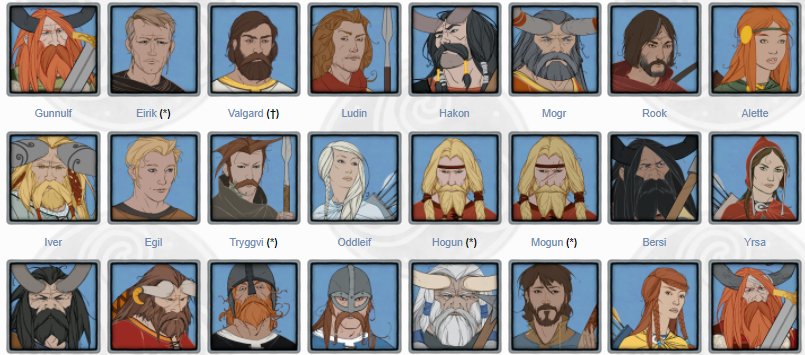The Banner Saga is a tactical role-playing game set in a Norse-inspired fantasy world. The game was originally published in 2014 by indie developers Stoic Studio on PC and mobile and ported to consoles in 2016. It features twenty-five playable characters spanning seven classes and two races- human and varl. The game features an original story divided into seven chapters that unfolds based on the decisions made by the player. The fieldnotes linked below were compiled during a personal playthrough of the game’s first chapter and beginning of the second, as well as an observed playthrough of the game’s first chapter.
Case Study
Game Mechanics
There are several layers to The Banner Saga’s game mechanics. It follows a single player versus game interaction pattern and features multiple types of objectives, as classified by Fullerton (2018). The game’s combat system features elements of capture as players strive to kill enemy units, as well as elements of alignment as combat takes place on a grid system in which tactical positioning is crucial. Elements of construction are also present as players must manage their army’s supplies and morale.
The rules and procedures of the combat system are intricate. Players control a party of up to six interchangeable characters. Prior to the battle commencing, players may position their characters on the battlefield. Turns alternate between the player and the enemy, regardless of how many characters are on either side. Each turn, the player may move a character a limited number of spaces or wait, then attack or use an ability. Damage is calculated based on the defender’s armour and the attacking character’s strength, which also serves as health. Players may choose to target the enemy’s armour rating or health. Willpower can be used to boost damage or increase range of movement. Renown is earned each time a character kills an enemy and is used to increase the character’s stats and unlock abilities. Characters that fall during battle are injured until healed.
Outside of battle, players manage the people, supplies, and morale of their army. Morale can be regenerated through rest and restores characters’ willpower, but at the cost of supplies. Playable characters act as resources as well, as they can be customized, interchanged, and can be permanently injured or killed. All three of Fullerton’s described sources of conflict are present: opponents in the form of the game-controlled enemies, obstacles in the form of battlefield hazards, and dilemmas in the form of difficult narrative choices made by the player.
The dramatic elements within the game- the hand-drawn artwork, engaging storytelling, and unique characters- serve to invest the player emotionally. Challenge and conflict are thus not limited to the difficulty of the game’s combat but can be elicited by presenting players with morally ambiguous choices that affect the story and its characters. The impact of player choice on the game’s story ensures that the outcome is uncertain both in how the story is resolved and which characters survive. This also adds replay value to the game as players may wish to try new characters and strategies and explore how making different choices affects the game’s outcome.
Race, Gender, Class, and Violence
It was unfortunately unsurprising that The Banner Saga suffered from a lack of diversity as it draws inspiration from Norse sagas; however, given that the game features fantasy characters such as giants and centaurs, the developers could have taken the liberty to add minority characters. During my hour and a half of gameplay I did not encounter any non-white characters. According to the game’s wiki, there are no playable characters of colour within the game.

Only allowing players to experience the game through white characters “internalizes in many gamers that those fantasy worlds weren’t designed for them” (Peckham, 2020). Peckham further asserts that racial bias is often unintentionally baked into games as a reflection of the lack of diversity within the gaming industry. Stoic Studio’s senior leadership team seems to reflect this observation.

The Banner Saga also suffers from a lack of female playable characters. It was not until the second chapter that I gained access to the first female character, Alette. I did not play long enough to gain a sense of how gender relations operate within the game. I noted that a male character suggested that Alette not take part in defending their village while it was under attack, but this seemed due to her age rather than her gender. Referring again to the game’s Wiki, all the female characters are relegated to the role of archer, a less physically imposing class within the RPG genre.
Issues surrounding class and violence were less obvious. I was unable to determine in my brief playthrough how class within the game’s medieval fantasy context may play a role. The game contains cartoon depictions of violence, but it is not trivialized as themes surrounding war will likely be explored and character deaths carry an emotional weight. The Dredge have thus far been depicted as an emotionless “other;” however, this is likely challenged in the game’s sequels as Dredge characters become playable.
Final Reflections
Gee (2008) argues that good commercial video games are “highly engaging problem spaces” that must encourage learning to provide increasingly appropriate challenge and keep players engaged (p. 229). The Banner Saga introduces the game’s complex battle system through a series of low stakes tutorials to ensure that players do not become overwhelmed. Tutorial battles were not so linear, however, to exclude the act of discovery. I often discovered a game mechanic or strategy accidently, such as inadvertently blocking the movement of a character. When I was unsure of how an interaction was calculated or an ability operated, the game provided resources and character information that I could refer to at any time, as well as the training tent feature where I could test new characters, abilities, and strategies.
These design features serve to promote mastery of the game’s mechanics as the player faces increasingly difficult challenges. Despite the relative simplicity of the early battles, there were noted differences in my approach compared to the player I observed. While I tended to play more cautious and learned the game’s mechanics by reading all the information available to me, the player I observed was more willing to learn through experimentation and an aggressive playstyle. The game designers created an engaging problem space by enabling multiple approaches to learning, problem-solving, and play. The Banner Saga is not simply a game of tactics, however. Its premise, aesthetic, and storytelling work together to create a dynamic system in which players become emotionally invested.
References
Fullerton, T. (2019). Game design workshop: A playcentric approach to creating innovative games (Fourth ed.). Taylor & Francis, CRC Press.
Gee, J. P. (2008). Cats and portals: Video games, learning, and play. American Journal of Play, 1(2), 229.
Peckham, E. (2020, June 21). Confronting racial bias in video games. https://techcrunch.com/2020/06/21/confronting-racial-bias-in-video-games/.
The Banner Saga Wiki. https://bannersaga.gamepedia.com/The_Banner_Saga_Wiki.

